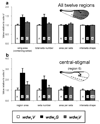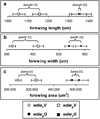Evolution of sex-specific wing shape at the widerwing locus in four species of Nasonia
- PMID: 20087390
- PMCID: PMC2834783
- DOI: 10.1038/hdy.2009.146
Evolution of sex-specific wing shape at the widerwing locus in four species of Nasonia
Abstract
How do morphological differences between species evolve at the genetic level? This study investigates the genetic basis of recent divergence in male wing size between species of the model parasitoid wasp Nasonia. The forewings of flightless Nasonia vitripennis males are 2.3 times smaller than males of their flighted sister species N. giraulti. We describe a major genetic contributor to this difference: the sex-specific widerwing (wdw) locus, which we have backcrossed from N. giraulti into N. vitripennis and mapped to an 0.9 megabase region of chromosome 1. This introgression of wdw from large-winged N. giraulti into small-winged N. vitripennis increases male but not female forewing width by 30% through wing region-specific size changes. Indirect evidence suggests that cell number changes across the wing explain the majority of the wdw wing-size difference, whereas changes in cell size are important in the center of the wing. Introgressing the same locus from the other species in the genus, N. longicornis and N. oneida, into N. vitripennis produces intermediate and large male wing sizes. To our knowledge, this is the first study to introgress a morphological quantitative trait locus (QTL) from multiple species into a common genetic background. Epistatic interactions between wdw and other QTL are also identified by introgressing wdw from N. vitripennis into N. giraulti. The main findings are (1) the changes at wdw have sex- and region-specific effects and could, therefore, be regulatory, (2) the wdw locus seems to be a co-regulator of cell size and cell number, and (3) the wdw locus has evolved different wing width effects in three species.
Figures





Similar articles
-
Non-coding changes cause sex-specific wing size differences between closely related species of Nasonia.PLoS Genet. 2010 Jan 15;6(1):e1000821. doi: 10.1371/journal.pgen.1000821. PLoS Genet. 2010. PMID: 20090834 Free PMC article.
-
The genetic basis of the interspecific differences in wing size in Nasonia (Hymenoptera; Pteromalidae): major quantitative trait loci and epistasis.Genetics. 2002 Jun;161(2):673-84. doi: 10.1093/genetics/161.2.673. Genetics. 2002. PMID: 12072464 Free PMC article.
-
Dissection of the complex genetic basis of craniofacial anomalies using haploid genetics and interspecies hybrids in Nasonia wasps.Dev Biol. 2016 Jul 15;415(2):391-405. doi: 10.1016/j.ydbio.2015.12.022. Epub 2015 Dec 23. Dev Biol. 2016. PMID: 26721604 Free PMC article.
-
Sex determination in the haplodiploid wasp Nasonia vitripennis (Hymenoptera: Chalcidoidea): a critical consideration of models and evidence.Semin Cell Dev Biol. 2007 Jun;18(3):371-8. doi: 10.1016/j.semcdb.2006.12.015. Epub 2007 Jan 13. Semin Cell Dev Biol. 2007. PMID: 17292644 Review.
-
The expanding genetic toolbox of the wasp Nasonia vitripennis and its relatives.Genetics. 2015 Apr;199(4):897-904. doi: 10.1534/genetics.112.147512. Genetics. 2015. PMID: 25855650 Free PMC article. Review.
Cited by
-
Fine-scale mapping of the Nasonia genome to chromosomes using a high-density genotyping microarray.G3 (Bethesda). 2013 Feb;3(2):205-15. doi: 10.1534/g3.112.004739. Epub 2013 Feb 1. G3 (Bethesda). 2013. PMID: 23390597 Free PMC article.
-
siRNA-Mediated Silencing of doublesex during Female Development of the Dengue Vector Mosquito Aedes aegypti.PLoS Negl Trop Dis. 2015 Nov 6;9(11):e0004213. doi: 10.1371/journal.pntd.0004213. eCollection 2015 Nov. PLoS Negl Trop Dis. 2015. PMID: 26544686 Free PMC article.
-
Sex linkage, sex-specific selection, and the role of recombination in the evolution of sexually dimorphic gene expression.Evolution. 2010 Dec;64(12):3417-42. doi: 10.1111/j.1558-5646.2010.01136.x. Epub 2010 Nov 3. Evolution. 2010. PMID: 20874735 Free PMC article.
-
Quantitative Trait Locus Analysis of Mating Behavior and Male Sex Pheromones in Nasonia Wasps.G3 (Bethesda). 2016 Jun 1;6(6):1549-62. doi: 10.1534/g3.116.029074. G3 (Bethesda). 2016. PMID: 27172207 Free PMC article.
-
Early memory in the parasitoid wasp Nasonia vitripennis.J Comp Physiol A Neuroethol Sens Neural Behav Physiol. 2015 Apr;201(4):375-83. doi: 10.1007/s00359-015-0989-4. Epub 2015 Feb 25. J Comp Physiol A Neuroethol Sens Neural Behav Physiol. 2015. PMID: 25712505
References
-
- Alpert KB, Grandillo S, Tanksley SD. fw2.2: a major QTL controlling fruit weight is common to both red- and green-fruited tomato species. Theoretical and Applied Genetics. 1995;91:994–1000. - PubMed
-
- Breeuwer JAJ, Werren JH. Hybrid Breakdown Between Two Haplodiploid Species: The Role of Nuclear and Cytoplasmic Genes. Evolution. 1995;49:705–717. - PubMed
-
- Campbell BC, Steffen-Campbell JD, Werren JH. Phylogeny of the Nasonia species complex (Hymenoptera: Pteromalidae) inferred from an internal transcribed spacer (ITS2) and 28S rDNA sequences. Insect Molecular Biology. 1993;2:225–237. - PubMed
Publication types
MeSH terms
Substances
Grants and funding
LinkOut - more resources
Full Text Sources

